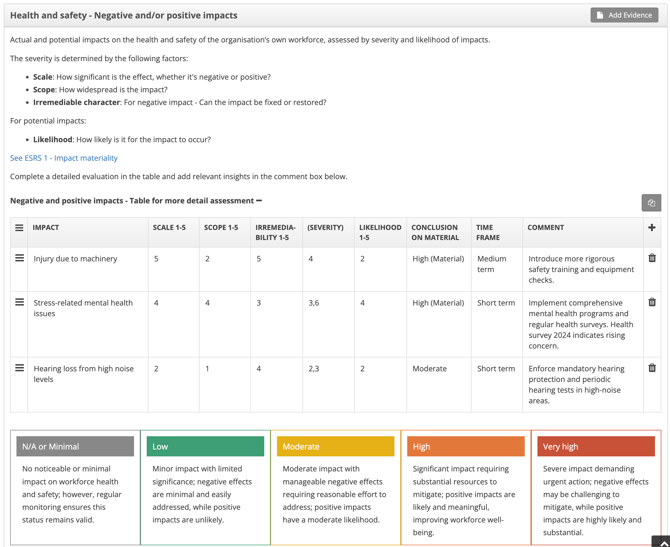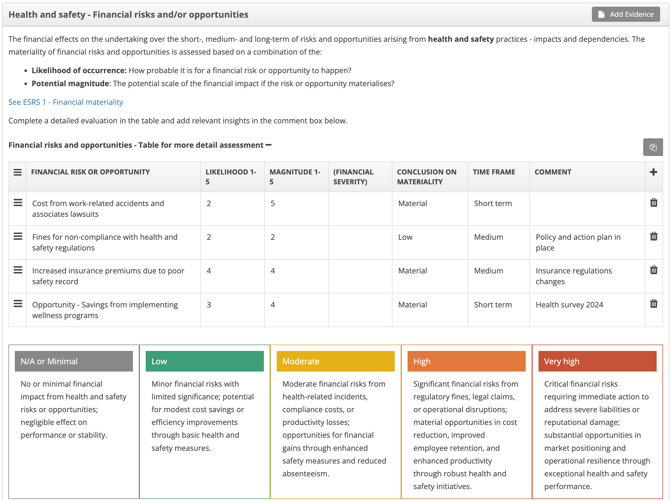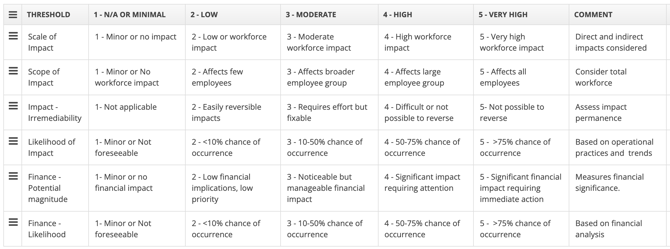1.4 How to Score Topics Using the 1–5 Scale
Assess each topic for both Impact and Financial Risk/Opportunity
Scoring sustainability topics is a critical part of your materiality assessment. It helps determine which topics are material (most important for your organisation) and therefore should be addressed in your sustainability strategy and reporting.
Klappir‑Strategy supports a dual-perspective assessment:
-
Impact Materiality – How your organisation affects people or the environment
-
Financial Materiality – How the topic may affect your organisation through risks or opportunities
1. Scoring Impact Materiality
Ask yourself:
📌 Does this topic have an actual or potential impact on people or the environment — and how severe is it?
Each topic can be assessed using four dimensions:
| Dimension | Description |
|---|---|
| Scale | How severe or significant is the impact? |
| Scope | How widespread is the impact (e.g. across people, ecosystems, locations)? |
| Irremediability | How reversible is the impact? |
| Likelihood | How likely is the impact to occur? |
Severity = (Scale + Scope + Irremediability) ÷ 3
You’ll then assess Likelihood separately.
Topics with high Severity and/or Likelihood (4 or 5) are typically marked as material.
2. Scoring Financial Risk or Opportunity
Ask yourself:
📌 Could this topic affect our business financially — through risk, costs, or strategic opportunities?
You’ll assess two dimensions:
| Dimension | Description |
|---|---|
| Magnitude | How large could the financial effect be? |
| Likelihood | How likely is it to occur? |
Financial Severity = (Magnitude + Likelihood) ÷ 2
Topics scoring from 3.5 or 4 to 5 are typically considered financially material.
The Over All Scoring Scale (Used Across All Dimensions)
| Score | Interpretation |
|---|---|
| 1 | Not applicable or minimal relevance |
| 2 | Low relevance |
| 3 | Moderate relevance |
| 4 | High relevance (Material) |
| 5 | Very high relevance (Material) |
💡 Topics scoring from 3.5 or 4 to 5 in either perspective are considered material and will move forward to the next steps (Policies, Actions, Targets, Reporting).
How to do it – Step by Step
1. Open a topic from the materiality list
Click on the topic to begin your assessment.

.
2. Score Impact Materiality:
-
Enter scores for: Scale, Scope, Irremediability, and Likelihood
-
Calculate and add in Severity
-
Decide if the topic is material from an impact perspective

In the table for more detail assessment you can:
-
Distinguish between positive and negative effects
-
Document multiple impacts per topic
-
Add detailed comments to support audit and review
3. Score Financial Risk/Opportunity:
-
Enter scores for: Magnitude and Likelihood
-
Calculate and add in Severity
-
Decide if the topic is material from a financial perspective

In the table for more detail assessment you can:
-
Distinguish between risk and opportunities per topic
-
Add detailed comments to support audit and review
Customise the Scoring Scale (Optional)
Klappir‑Strategy allows you to define what each score means in your own context.
Example: Assessment Scale for S1 Own workforce

You can adapt the definitions per topic or dimension.
Why This Matters
-
Aligns with ESRS 2 (Draft July 2025) — including IRO-1 and IRO-2
-
Helps ensure your materiality decisions are documented, auditable, and defensible
-
Supports your ESG ratings by showing how decisions are made
-
Feeds into your Policies, Actions, and Reporting
Standards Alignment
| Standard | Relevance |
|---|---|
| ESRS (Draft July 2025) | Requires assessment of both impact and financial materiality. See ESRS 2 IRO‑1, IRO‑2. |
| VSME | Scoring is not required, but this method helps determine which topics are applicable. |
Outcome of Step 2.4
By completing this step, you will have:
-
Assessed each sustainability topic from two perspectives:
Impact materiality and Financial risk/opportunity -
Applied a consistent 1–5 scoring system for each dimension
-
Used a customisable scale that reflects your organisation’s context
-
Built the foundation for deciding which topics are material
📌 Remember: Topics scoring 4 or 5 in either perspective are considered material and will move forward into the next steps — Policies, Actions, Targets, and Reporting.
Go to the next step: